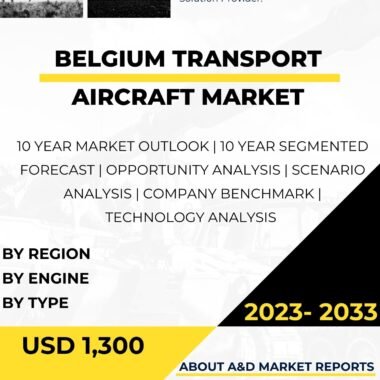Description
The China transport aircraft market has experienced significant growth and development in recent years. With China’s focus on expanding its transportation capabilities, improving logistical support, and enhancing its defense capabilities, there has been a substantial demand for advanced transport aircraft. This market analysis provides an overview of the China transport aircraft market, including key players, market drivers, challenges, and future prospects.
The China transport aircraft market is characterized by the presence of both domestic and international players. Domestic companies, such as China Aerospace Science and Technology Corporation (CASC), Xi’an Aircraft Industrial Corporation (XAC), and Shaanxi Aircraft Company, have made significant contributions to the development, production, and supply of transport aircraft. These companies have invested in research and development to enhance the capabilities of their aircraft and meet the specific requirements of the Chinese aviation industry.
International players, including renowned aircraft manufacturers such as Airbus, Boeing, and Lockheed Martin, have also established collaborations and partnerships in China. These partnerships have facilitated technology transfer, knowledge exchange, and joint development programs, contributing to the advancement of transport aircraft capabilities in China.
The market is driven by several factors. One of the primary drivers is China’s focus on expanding its transportation capabilities and improving logistical support. Transport aircraft play a crucial role in providing airlift capabilities for personnel, equipment, and supplies. As China seeks to enhance its military mobility, support disaster relief operations, and strengthen its logistical infrastructure, the demand for advanced transport aircraft has grown.
Furthermore, the need for indigenous transport capabilities and self-sufficiency in aviation has fueled the demand for transport aircraft in China. Developing and producing transport aircraft domestically allows China to reduce reliance on foreign suppliers, enhance its defense industrial base, and promote technological advancement. As China aims to strengthen its indigenous defense capabilities and expand its aviation industry, the demand for domestically produced transport aircraft has increased.
Technological advancements have played a crucial role in the growth of the China transport aircraft market. Domestic companies have focused on developing indigenous transport aircraft with improved payload capacity, range, fuel efficiency, and avionics. China has made significant progress in the development of various transport aircraft, including medium-range transport aircraft, strategic transport aircraft, and aerial refueling tanker aircraft.
China has successfully developed and deployed advanced transport aircraft, such as the XAC Y-20, which provides strategic airlift capabilities for military and civilian applications. The development of medium-range transport aircraft, such as the CASC MA700, has enhanced China’s capabilities in regional airlift operations. Additionally, aerial refueling tanker aircraft, such as the CASC HU-6, have been developed to provide in-flight refueling support for other aircraft.
Another driver of the China transport aircraft market is the civilian aviation market. China has experienced rapid growth in its civil aviation sector, with increasing demand for air travel and cargo transportation. This has led to a growing need for modern and efficient transport aircraft to meet the demands of the civil aviation market. The development of regional transport aircraft, such as the MA700, caters to the growing regional air travel market within China and the Asia-Pacific region.
However, the China transport aircraft market also faces certain challenges. One of the primary challenges is the need for continuous investment in research and development to stay ahead of evolving technologies, emerging market demands, and changing operational requirements. As aviation technologies advance and market demands evolve, China must invest in innovation and advanced technologies to maintain its transport aircraft capabilities.
Additionally, the market faces challenges related to international competition and market saturation. The global transport aircraft market is highly competitive, with several established players offering advanced transport aircraft solutions. China must differentiate its offerings, provide competitive pricing, and focus on the unique requirements of its domestic and export markets.
Looking ahead, the future prospects for the China transport aircraft market are promising. China’s commitment to expanding its transportation capabilities, improving logistical support, and strengthening its defense and civil aviation sectors will continue to drive investments in transport aircraft. Ongoing research and development efforts, collaborations between domestic companies and international partners, and the integration of emerging technologies, such as advanced materials, fuel-efficient engines, and improved avionics, are expected to result in the introduction of more advanced and capable transport aircraft.
The integration of advanced materials and fuel-efficient engines may shape the future of the market. Advanced materials, such as carbon fiber composites, can reduce aircraft weight, improve fuel efficiency, and enhance overall performance. Fuel-efficient engines, including high-bypass turbofan engines, can improve fuel consumption, reduce emissions, and increase range and payload capacity.
In conclusion, the China transport aircraft market has witnessed significant growth driven by the country’s focus on expanding its transportation capabilities, improving logistical support, and enhancing its defense and civil aviation sectors. Technological advancements, collaborations between domestic and international players, and the government’s commitment to indigenous defense capabilities have contributed to the development and deployment of advanced transport aircraft. Challenges related to evolving technologies, international competition, and market saturation need to be addressed. With ongoing research and development, collaborations, and the integration of emerging technologies, the future of the China transport aircraft market looks promising, with opportunities for further growth, innovation, and advancements in transport aircraft capabilities.




